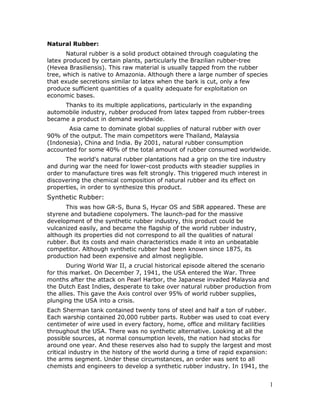
Natural vs Synthetic Rubber: A History
- 1. Natural Rubber: Natural rubber is a solid product obtained through coagulating the latex produced by certain plants, particularly the Brazilian rubber-tree (Hevea Brasiliensis). This raw material is usually tapped from the rubber tree, which is native to Amazonia. Although there a large number of species that exude secretions similar to latex when the bark is cut, only a few produce sufficient quantities of a quality adequate for exploitation on economic bases. Thanks to its multiple applications, particularly in the expanding automobile industry, rubber produced from latex tapped from rubber-trees became a product in demand worldwide. Asia came to dominate global supplies of natural rubber with over 90% of the output. The main competitors were Thailand, Malaysia (Indonesia), China and India. By 2001, natural rubber consumption accounted for some 40% of the total amount of rubber consumed worldwide. The world's natural rubber plantations had a grip on the tire industry and during war the need for lower-cost products with steadier supplies in order to manufacture tires was felt strongly. This triggered much interest in discovering the chemical composition of natural rubber and its effect on properties, in order to synthesize this product. Synthetic Rubber: This was how GR-S, Buna S, Hycar OS and SBR appeared. These are styrene and butadiene copolymers. The launch-pad for the massive development of the synthetic rubber industry, this product could be vulcanized easily, and became the flagship of the world rubber industry, although its properties did not correspond to all the qualities of natural rubber. But its costs and main characteristics made it into an unbeatable competitor. Although synthetic rubber had been known since 1875, its production had been expensive and almost negligible. During World War II, a crucial historical episode altered the scenario for this market. On December 7, 1941, the USA entered the War. Three months after the attack on Pearl Harbor, the Japanese invaded Malaysia and the Dutch East Indies, desperate to take over natural rubber production from the allies. This gave the Axis control over 95% of world rubber supplies, plunging the USA into a crisis. Each Sherman tank contained twenty tons of steel and half a ton of rubber. Each warship contained 20,000 rubber parts. Rubber was used to coat every centimeter of wire used in every factory, home, office and military facilities throughout the USA. There was no synthetic alternative. Looking at all the possible sources, at normal consumption levels, the nation had stocks for around one year. And these reserves also had to supply the largest and most critical industry in the history of the world during a time of rapid expansion: the arms segment. Under these circumstances, an order was sent to all chemists and engineers to develop a synthetic rubber industry. In 1941, the 1
- 2. total output of synthetic rubber barely topped 8,000 tons, consisting largely of products not suitable for tires. The nation's survival depended on its capacity to manufacture over 800,000 tons of products that had barely begun to be developed. There were few detailed instructions on how the factories should organize themselves to produce this vast amount. No facilities had been built, nor were there any ways of producing enough raw materials to produce rubber. A wide variety of synthetic rubbers have been developed since this product was first discovered. As massive investments were required to develop these different varieties, the production technology was heavily concentrated in long-established global enterprises such as DuPont, Bayer, Shell, Basf, Goodyear, Firestone, Michelin, EniChem, Dow, and Exxon. The use of rubber is widespread, as the characteristics and properties of these elastomers make them useful in almost all economic sectors: automobiles, footwear, civil construction, plastics, hospital materials and others that are of crucial importance in the daily life of society. As they are most widely used to produce tires, the SBR and BR varieties are the most widely consumed type of synthetic rubber. 2
- 3. 3